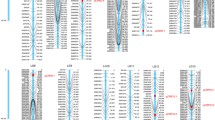Abstract
This is the first report on molecular studies and tagging of the dt gene regulating determinate growth habit in sesame. The development of determinate cultivars has become an objective of high priority in sesame breeding programmes. Random amplified polymorphic DNA (RAPD) and inter simple sequence repeat (ISSR) techniques were investigated for the development of molecular markers for this induced mutant character. In order to identify molecular markers linked to determinate growth habit, a segregating F2 population was developed from a cross between determinate mutant line, dt-1 and an indeterminate Turkish cultivar, Muganlı-57. Using the F2 segregating population and bulked segregant approach, two ISSR marker loci originated from a (CT)8AGC primer were detected. The association was confirmed by analysing the ISSR profile from single plants originating from a F2 segregating population for the trait. This marker is potentially useful for assisting sesame breeding programmes by marker assisted selection and can facilitate the integration of determinate growth habit into new genetic backgrounds.

Similar content being viewed by others
References
Archak S, Gaikwad AB, Gautam D et al (2003) DNA fingerprinting of Indian cashew (Anacardium occidentale L.) varieties using RAPD and ISSR techniques. Euphytica 230:397–404. doi:10.1023/A:1023074617348
Arslan Ç, Uzun B, Ülger S et al (2007) Determination of oil content and fatty acid compositions of sesame mutants suited for intensive management conditions. J Am Oil Chem Soc 84:917–920. doi:10.1007/s11746-007-1125-6
Ashri A (1998) Sesame breeding. Plant Breed Rev 16:179–228
Bhat KV, Babrekar PP, Lakhanpaul S (1999) Study of genetic diversity in Indian and exotic sesame (Sesamum indicum L.) germplasm using random amplified polymorphic DNA (RAPD) markers. Euphytica 110:21–33. doi:10.1023/A:1003724732323
Çağırgan MI (2001) Mutation techniques in sesame (Sesamum indicum L.) for intensive management: confirmed mutants. In: Sesame improvement by induced mutations, IAEA-TECDOC-1195. IAEA, Vienna, pp 31–40
Çağırgan MI (2006) Selection and morphological characterization of induced determinate mutants of sesame. Field Crops Res 96:19–24. doi:10.1016/j.fcr.2005.06.010
Danilova TV, Karlov GI (2006) Application of inter simple sequence repeat (ISSR) polymorphism for detection of sex-specific molecular markers in hop (Humulus lupulus L.). Euphytica 151:15–21. doi:10.1007/s10681-005-9020-4
Day JS (2000) Development and maturation of sesame seeds and capsules. Field Crops Res 67:1–9. doi:10.1016/S0378-4290(00)00073-3
Dellaporta SL, Wood J, Hicks JB (1985) Maize DNA miniprep. In: Messing J, Sussex I (eds) Molecular biology of plants: a laboratory course manual. Cold Spring Harbor Press, New York, pp 36–37
Dixit A, Jin MH, Chung JW (2005) Development of polymorphic microsatellite markers in sesame (Sesamum indicum L.). Mol Ecol Notes 5(4):736–738. doi:10.1111/j.1471-8286.2005.01048.x
Fuentes JL, Correa-Victoria FJ, Escobar F et al (2007) Identification of microsatellite markers linked to the blast resistance gene Pi-1(t) in rice. Euphytica. doi:10.1007/s10681-007-9497-0
Isshiki S, Umezaki T (1997) Genetic variations of isozymes in cultivated sesame (Sesamum indicum L.). Euphytica 93:375–377. doi:10.1023/A:1002985625087
Kim DH, Zur G, Danin-Poleg Y et al (2002) Genetic relationship of sesame germplasm collection as revealed by inter-simple sequence repeats. Plant Breed 121:259–262. doi:10.1046/j.1439-0523.2002.00700.x
Michelmore RW, Paran I, Kesseli RV (1991) Identification of markers linked to disease-resistance genes by bulked segregant analysis: a rapid method to detect markers in specific genomic regions by using segregating populations. Proc Natl Acad Sci USA 88:9828–9832. doi:10.1073/pnas.88.21.9828
Polley A, Seigner E, Ganal MW (1997) Identification of sex in hop (Humulus lupulus L.) using molecular markers. Genome 40:357–361. doi:10.1139/g97-048
Ratnaparkhe MB, Tekeoglu M, Muehlbauer FJ (1998) Inter-simple-sequence-repeat (ISSR) polymorphisms are useful for finding markers associated with disease resistance gene clusters. Theor Appl Genet 97:515–519. doi:10.1007/s001220050925
Uzun B, Çağırgan MI (2006) Comparison of determinate and indeterminate lines of sesame for agronomic traits. Field Crops Res 96:13–18. doi:10.1016/j.fcr.2005.04.017
Uzun B, Lee D, Donini P et al (2003) Identification of a molecular marker linked to the closed capsule mutant trait in sesame using AFLP. Plant Breed 122:95–97. doi:10.1046/j.1439-0523.2003.00787.x
Uzun B, Lee D, Çağırgan MI (2005) Identification of a RAPD marker associated with the closed capsule mutant trait in sesame (abstract in English). The sixth field crops congress of Turkey, Antalya, pp 1113–1116, 5–9 September 2005
Uzun B, Akkaya MS, Ünver T et al (2006) Development of SCAR markers linked to closed capsule mutant trait in sesame (Sesamum indicum L.). XV FESBP congress federation of European societies of plant biology, Lyon, p 109
Uzun B, Arslan Ç, Karhan M et al (2007) Fat and fatty acids of white lupin (Lupinus albus L.) in comparison to sesame (Sesamum indicum L.). Food Chem 102:45–49. doi:10.1016/j.foodchem.2006.03.059
Williams JGK, Kubelik AR, Livak KJ et al (1990) DNA polymorphisms amplified by arbitrary primers are useful as genetic markers. Nucleic Acids Res 18:6531–6535. doi:10.1093/nar/18.22.6531
Zietkiewicz E, Rafalski A, Labuda D (1994) Genome fingerprinting by simple sequence repeat (SSR)-anchored polymerase chain reaction amplification. Genomics 20:176–183. doi:10.1006/geno.1994.1151
Acknowledgements
The authors are thankful to the Akdeniz University Scientific Project Unit and the Scientific and Technological Research Council of Turkey (TUBITAK) for their financial supports under the project numbers of 2004.01.0104.002 and TOGTAG-3300, respectively. We express our heartfelt thanks to Drs. H. Basım and M. S. Balcıoglu of Akdeniz University, Antalya, Turkey and Mr. S. Furat of West Mediterranean Agricultural Research Institute, Antalya, Turkey for sharing their infrastructure with us. We also appreciate to Dr. Anne Frary of İzmir Institute of Technology, İzmir, Turkey for reviewing the manuscript.
Author information
Authors and Affiliations
Corresponding author
Rights and permissions
About this article
Cite this article
Uzun, B., Çağırgan, M.İ. Identification of molecular markers linked to determinate growth habit in sesame. Euphytica 166, 379–384 (2009). https://doi.org/10.1007/s10681-008-9818-y
Received:
Accepted:
Published:
Issue Date:
DOI: https://doi.org/10.1007/s10681-008-9818-y




